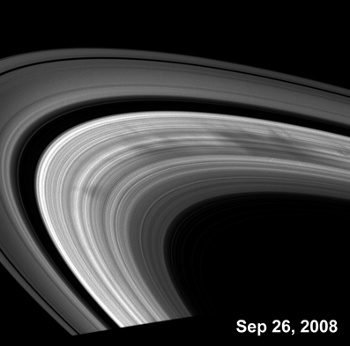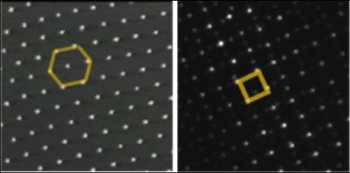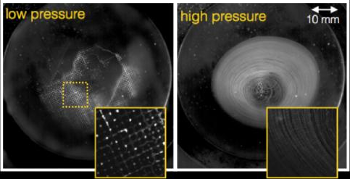Plasma Crystals
January 11, 2016
Prior to the introduction of inexpensive
digital display devices, such as
seven-segment LED displays,
scientific instrumentation contained
nixie tube displays (see figure). These were
vacuum tube displays, and they were not out of place in those instruments with their vacuum tube
circuitry. As
transistors replaced vacuum tubes in most instruments, nixie tubes were still the best display choice.

The decimal digits displayed on nixie tubes. (Modified Wikimedia Commons image by Hellbus.)
Nixie tubes operate by
electrically-exciting a
plasma in
neon gas. As such, they are a slightly advanced version of
neon lamps in which electrically-excited plasma produces
light in a
glow discharge. This useful
phenomenon in the
noble gases was discovered by
William Ramsay (1852-1916), who received the 1904
Nobel Prize in Chemistry for his isolation of
helium, neon,
argon,
krypton and
xenon.

Noble gases glowing under inductive excitation. (Wikimedia Commons source images of helium, neon, argon, krypton, and xenon, by Jurii.)
Plasma is supposedly the "
fourth state of matter," although I've always thought that this characterization was somewhat
overblown. After all, we've recognized three states of matter,
solids,
liquids, and
gases from antiquity. Should this plasma variant of a gas, produced under exotic conditions, really have such a special designation?
To form a plasma, you excite a gas by
heating, by application of an
electric field, or by application of an
electromagnetic field to the extent that it separates into a sea of
electrons and
positive ions. There's quite a bit of natural plasma in the
Solar System, since the
Sun is a ball of
hydrogen and helium plasma. There's no way that hydrogen and helium could escape complete
ionization at
corona temperatures of millions of degrees
kelvin.
Plasma
technology still had some life left after nixie tubes in the form of
plasma displays. In such displays, an electrically-excited plasma produces
ultraviolet light that's used to excite multi-colored
phosphors. Plasma display was an important technology for
larger area television screens until the
present decade. Now,
liquid-crystal displays are the dominant large screen display technology.
Just as
dust bunnies make the undersides of
furniture more interesting,
dusty plasmas are hosts to a lot of new
physics. The
American Physical Society Division of Plasma Physics had several scheduled
papers on dusty plasmas in
its 57th Annual Meeting, November 16–20, 2015, in
Savannah, Georgia. Dust particles will be
dielectric,
conductive, or
magnetic, so they will interact with the charged plasma in interesting ways.
One interesting natural occurrence of dusty plasma is in
Saturn's rings. In 1980, the
Voyager spacecraft found
radial spokes in Saturn's
B ring. Such radial features cannot be explained by
gravitation. While the cause of these apparently
seasonal spokes is still unknown, it's suspected that they are
microscopic dust particles that are closely
synchronized with the
rotation of
Saturn's magnetosphere.

Spokes in Saturn's B ring, imaged by the Cassini spacecraft on September 28, 2008.
(Still frame from a NASA/JPL/Space Science Institute video, via Wikimedia Commons.)
Papers presented at the plasma physics meeting include work by
scientists at
Auburn University, the
University of Iowa, and the
University of California, San Diego, on magnetized dusty plasmas in
electric field gradients.[1-3] One interesting observed effect is the formation of an ordered
lattice of these particles; that is, a
crystal embedded in the plasma.[1-3]
While
molecular dynamics simulations of such dusty plasmas were done,
experiments were also performed on magnetic crystals embedded in plasma in the
Magnetized Dusty Plasma Experiment (MDPX) hosted at Auburn University and funded by the
US Department of Energy and the
National Science Foundation.[1,4] The MDPX is the first experiment of this kind performed in the US.[3]
The MDPX device can produce a uniform
magnetic field up to 3.0
tesla. In these experiments, the ordered structures were observed at magnetic fields above 1 tesla.[2] The dusty plasma structures are diminished as the
neutral pressure is increased, and they align with the spatial structure of electric field imposed by a
wire mesh placed in the plasma.[1,2] As a consequence, changing the
symmetry of the mesh changes the lattice type (see figure).[3]

Choose your symmetry.
hexagonal and square lattice arrays of magnetic particles in a dusty plasma.
(Max Planck Institute image)
Plasmas processes are used in such things as
semiconductor device fabrication and
fusion power experiments. Control of
nanometer-sized particles in plasmas could lead to interesting applications.[3]

Application of pressure destroys the lattice arrays of magnetized particles in a plasma.
(Auburn University/Edward Thomas image.)
References:
- Brian Bender and Edward Thomas, "Analysis of particle trajectories in a simulated, magnetized dusty plasma in a radially-increasing electric field,", Paper JP12.00034 of the 57th Annual Meeting of the APS Division of Plasma Physics (November 16-20, 2015, Savannah, Georgia).
- Edward Thomas, Spencer LeBlanc, Brian Lynch, Uwe Konopka, Robert Merlino, and Marlene Rosenberg, "Imposed, ordered dust structures and other plasma features in a strongly magnetized plasma," Paper UP12.00060 of the 57th Annual Meeting of the APS Division of Plasma Physics (November 16-20, 2015, Savannah, Georgia).
- Made to order: Researchers discover a new form of crystalline matter, American Physical Society Press Release, November 11, 2015.
- Magnetized Dusty Plasma Experiment (MDPX) Web Site.
- Edward Thomas Jr., Brian Lynch, Uwe Konopka, Robert L. Merlino, and Marlene Rosenberg, "Observations of imposed ordered structures in a dusty plasma at high magnetic field," Phys. Plasmas, vol. 22, no. 3 (March, 2015), Document No. 030701, doi:10.1063/1.4914089.
Permanent Link to this article
Linked Keywords: Digital; display device; seven-segment LED display; scientific instrument; scientific instrumentation; nixie tube; vacuum tube; electronic circuit; circuitry; transistor; decimal; numerical digit; Wikimedia Commons; electron excitation; electrically-excited; plasma; neon gas; neon lamp; light; glow discharge; phenomenon; noble gases; William Ramsay (1852-1916); Nobel Prize in Chemistry; helium; argon; krypton; xenon; inductively coupled plasma; inductive excitation; state of matter; fourth state of matter; overblown; solid; liquid; gas; heat; electric field; electromagnetic field; electron; positive ion; Solar System; Sun; hydrogen; ionization; corona; temperature; kelvin; technology; plasma display; ultraviolet light; phosphor; large-screen television technology; larger area television screens; 2010s; liquid-crystal display; dust bunny; dust bunnies; furniture; dusty plasma; physics; American Physical Society; Division of Plasma Physics; academic publishing; paper; 57th Annual Meeting; Savannah, Georgia; dielectric; electrical conductor; conductive; magnetic; rings of Saturn; Voyager spacecraft; radial; spoke; B ring; gravitation; seasonal; microscopic; synchronization; synchronized; rotation; magnetosphere of Saturn; Cassini spacecraft; NASA/JPL/Space Science Institute; scientist; Auburn University; University of Iowa; University of California, San Diego; electric field gradient; lattice; crystal; molecular dynamics; computer simulation; experiment; Magnetized Dusty Plasma Experiment (MDPX); US Department of Energy; National Science Foundation; magnetic field; tesla; neutral pressure; wire mesh; symmetry; hexagonal; square; Max Planck Institute; semiconductor device fabrication; fusion power; nanometer.